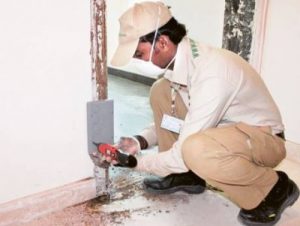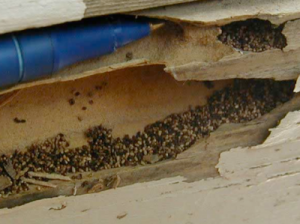
Unlike whole-structure termite treatment, which works an entire house up, spot treatment concerns only a small area (less than 10 square feet), the location where the pests has been found.
Adjacent areas prone to termite invasion are not treated.
Hide content
- When is this procedure applied?
- What are the kinds of spot treatment for drywood termites?
- Poisonous liquids, foams or dusts
- Biological control
- Electrocution
- Microwaves
- Wood removal
- Useful articles
- Helpful video
- Conclusion
When is this procedure applied?
Spot (localized) treatment is used in these circumstances:
- when it feels too inconvenient to treat the entire house;
- when it’s necessary to save money;
- when number of colonies within a house is limited, their locations are easily reachable and known for sure.
These circumstances arise from characteristics of this method.
The point is that on the one hand it demands less money and effort, but on the other hand:
- it requires precise detection of all colonies;
- doesn’t guarantee complete termite elimination;
- doesn’t prevent future invasions;
- it may appear ineffective if the vermin has congested the entire house (in this case you should mind a whole-structure treatment).
Besides, it’s not recommended drywood termite spot treatment by oneself. In fact, it’s not recommended to treat termites by oneself at all.If termites have invaded your house, you should rather resort to professional help for one simple reason: it’s generally difficult to fight them off by one’s forces.
What are the kinds of spot treatment for drywood termites?
Totally, there’re six main options how to spot treat drywood termites:
- liquids;
- dusts;
- foams;
- biological control;
- electrocution;
- microwaves;
- wood removal.
Poisonous liquids, foams or dusts
In order to attempt killing the pests with one of these substances, you should follow the steps:
- Drill holes into the timber with 3/16 inch drill (the exact center of the wood should be drilled into).
- Pump the insecticide into the holes throughout all gallery.
- Plug the holes with wooden dowels or seal with something else.
However, too much dust can plug the galleries, and the termites will wall off and isolate these areas, so you should mind the amounts.As for foams, you can try of these recommended aerosols:
- Termidor Foam;
- Termidor Dry;
- Premise Foam;
- Alpine Foam.
When it comes to dust, you may try:
- Timbor;
- TriDie.
Among liquid options, the most widespread products are:
- Boracare (the most commonly used);
- XT-2000;
- Termidor liquid.
This method:
- provides long-term effect;
- is quite easy to apply;
- covers hidden infestations (for foams).
As you see, these are pretty strong advantages.
Special precautions depend on what substance you use.
For example, some like XT-2000 or Boracare are practically non-toxic for humans, but some of them are.
So you should probably wear gas-mask and gloves while handling one and then vacate your house for a while until all traces are gone.
However in general the formulas are designed in such a way that the poisons were only poisonous for insect.
All in all, you’ll need to read a user’s manual for the one particular substance you’re going to apply.
Except for minor possibility of getting poisoned, there’s only one disadvantage this method bears: you’ll need to drill holes into the timber, which is apparently harmful for items made of it.Biological control
For now only one biological drywood termite control measure has been invented. Beneficial nematodes are natural insect parasites, harmless for human, plants and pets (unless termites are your pets).
The burrow into these insects and cause their death within about 48 hours.
All you need to do is to spray beneficial nematodes into infested rooms and wait until they grow up, reproduce and start fighting against your common enemy.
This method compares favorably with the one that was mentioned above because it’s totally chemical-free. However, there’re three drawbacks:
- efficiency rate is far from 100%;
- initially the nematode technique was aimed at fighting subterranean termites, rather than drywood ones;
- if you don’t spray the nematodes right away after buying, they die (however, you can put them into a refrigerator to preserve).
Here’re a few product names that may be found in your local store:
- NemaSeek
- NemAttack
Since the method is simple and harmless, special precautions are not needed.
Learn more about drywood termites: signs of their activity; best methods of treatment and DIY methods; how to get rid of them in furniture?Electrocution
Moreover, you can fry drywood termites up right into their nests. To manage that, you’re going to need a special electric gun.
Such a device emits current of high voltage (up to 90,000), but low amperage (~0,5 A), hence it’s relatively harmless for humans, wooden items and home electric circuit.
Then you should find the colony(ies) and apply it. It’s as simple as that. Though, to enhance the effect, you’ll probably have to drill some holes into the infested wood before “shooting”.
Advantages:
- the device is portable;
- after being bought, it only needs to be recharged, no consumables needed;
- the method is chemical-free.
Disadvantages:
- still it may leave some burns on the wood;
- as other spot treatments, it demands precise colony detection;
- efficacy depends;
- drilling holes needed.
One more intricate disadvantage is that the special electric guns for termite eradication can hardly be found anywhere, either online or in DIY stores, which makes using this method quite challenging.
Yet, if you are lucky enough, you can attempt to find BP-2000 Electro-Gun by Etex ltd, which is perhaps the one of a kind.Microwaves
Microwaves kill termites by causing fluids inside their cells to boil, which destroys cell membranes. Among the advantages, you can find these:
- as the electric gun, microwave exterminating device, is portable and can be carried anywhere you spot a colony;
- high efficacy.
As for minuses,
- heat areas with heat sinks cannot be treated properly;
- highly dependent on treatment time and wattage;
- requires precise colony detection;
- total system cost may reach incredible $5500, which makes such gizmos reasonable for professional use only;
- few firms now offer microwave devices.
However, among those who do, there’s Wavelength Emts Inc, which offer a product named The Proto2GE575 microwave termite treatment system.
If you still dare to use one, the step by step process is located on the user manual’s pages from 1 to 3. Besides, in this manual you can find strict safety regulations, which are absolutely essential to follow.Wood removal
It doesn’t even worth mentioning that the most obvious way to get rid of anything that can be carried away is to carry it away. In case of termites, you can carry them away along with the colony in a wooden item they’ve settled down in.
The advantage of such method is also pretty obvious: it only costs a thing you’re going to throw out. Alas, the disadvantage is that the infested item may appear a load-bearing beam, which makes this measure inapplicable, unless you cautiously replace the old beam with another.
Here you can learn more information about effective treatment method called tenting (fumigation): dangers for termites, preparing for fumigation and cleaning after, how long does this procedure last?
Useful articles
If you interested in more information of termites we recommend you to read the following articles:
- All types of termites. Are they harmful to humans? Can they bite you? And what is the difference between drywood and subterranean ones?
- What does swarmers of different species look like: drywood, subterranean, formosan?
- Signs of infestation outside and in the house: in walls or furniture.
- What does termite holes look like? What is droppings and is it toxic to humans? Do termites make noises?
- Posible termite damage, how does it look like? Examples of damage in walls and wood floors.
- All about flying termites: how do they look like, swarming season and what to do if there are swarmers in your house?
- How do they do nests and mounds? How to find it in your garden or inside the house?
- Termite life cycle – from egg to larvae. And social hierarchy: workers, soldiers, queen.
Helpful video
Find out the difference between spot treatment and tent fumigation for drywood termites:
Conclusion
In sum, termite spot treatment is a good remedial measure in minor cases of drywood termite invasion. Of all methods mentioned, poisoning the pests with chemicals may appear to be the most sufficient one, as it’s quite effective, available, easy to use and comparatively harmless.
Among all poisons, BoraCare on the basis of boric acid appears to be the best one, not least because it’s completely harmless for humans, unless drunk.
Besides you can resort to some chemical-free methods, e.g. microwaves or electrocution, though these methods are difficult to get; or you can simply saw off the piece of infected wood and take it to a junkyard.
Unfortunately, as a very questionable technique, beneficial nematodes assault cannot be advised for termite treatment, especially for treatment of drywood termites.

